Physical Address
304 North Cardinal St.
Dorchester Center, MA 02124
A reactive proliferation of fibroblasts/myofibroblasts confined to the boundaries of the wound forming short fascicles, whorls, or nodules, typically lacking keloidal collagen
Generally associated with previous local trauma or burns
Most commonly occurs in the second decade of life
Incidence after surgery from 40% to 70%, after burns from 30% to 90%
Lesions developing in the background of burns have a higher incidence in children
Familial predisposition common
No racial predilection
Predilection for chest, back, shoulders, buttocks, and knees
Slightly raised lesion of reddish discoloration
Generally not thicker than 2 mm
Remains confined within the boundaries of the wound
Occurs shortly after injury, generally within week(s), and usually flattens spontaneously within 1 to 2 years
Occasionally associated with pruritus and/or pain
Extensive lesions associated with limited mobility and possibly also contractions
Shows tendency to flatten and regresses over time
Recurrences after simple excision in up to 10%
Fascicles, whorls, and/or nodules composed of spindle-shaped fibroblasts/myofibroblasts
Frequently arranged parallel to the epidermis
Generally more cellular than keloids
By definition no wiry (keloidal) collagen
Increased amounts of small blood vessels with frequent perpendicular orientation to the epidermis
The epidermis can be atrophic
A foreign body granulomatous reaction occasionally present
Early lesions characterized by (opposite features typical for late lesions)
Increased cellularity
Increased amount of inflammatory cell infiltrate
Numerous capillaries
Distinction from keloids can be difficult. In the latter, however, wiry collagen is present
Desmoid or superficial fibromatosis (on small biopsy)
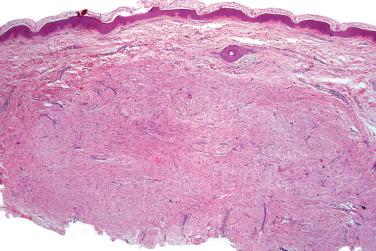
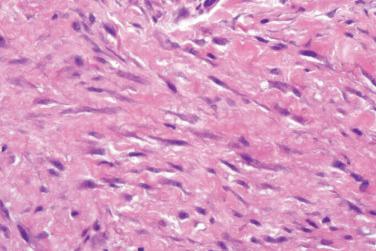
A reactive proliferation of fibroblasts/myofibroblasts extending beyond the confines of the wound, characterized by the presence of thick (wiry) collagen bundles frequently arranged in an irregular pattern
Predisposing conditions include skin incision, local trauma, various inflammatory skin conditions, and burns; spontaneous occurrence not uncommon
Highest incidence in the second decade of life
More common in certain ethnic groups, including Asian, black, and Hispanic populations, with the incidence in these groups as high as 15% (in other races the incidence varies from 0.2% to 1%)
Familial predisposition common
Both autosomal-dominant and -recessive modes of inheritance reported
Raised lesion, frequently associated with reddish discoloration
Painful and/or pruritic
Predilection for earlobes, shoulders, anterior chest (in particular presternal area), upper arm, and cheeks
Typically grows beyond the confines of the original wound
Develops months or even years after the initial injury, most commonly from 3 months to 1 year
Multiple lesions not uncommon
Does not regress over time
Resistant to various forms of treatment
High recurrence rate after simple surgical excision (50%–80%)
Thick, eosinophilic, or “glassy” wiry hyalinized collagen bundles (e.g., keloidal collagen) arranged in a haphazard pattern represent the hallmark of the entity, but prominent in only up to 55% of cases
Keloidal collagen admixed with spindle-shaped fibroblasts forming whorls, nodules, or fascicles
Fibroblasts generally represent a minor component of the lesion
Mucinous degeneration can be seen
Additional discriminative features from hypertrophic scar
No flattening of the overlying epidermis
No fibrosis of the papillary dermis
Absence of vertically oriented blood vessels
Prominent disarray of fascicles/nodules
Presence of tonguelike advancing edge
Prominent fascialike hypocellular fibrous band in parallel with the epidermis, usually in the deeper aspects of the lesion
Distinction from hypertrophic scar may be difficult on histological grounds alone and in small biopsies
Desmoid or superficial fibromatosis (on small biopsy)
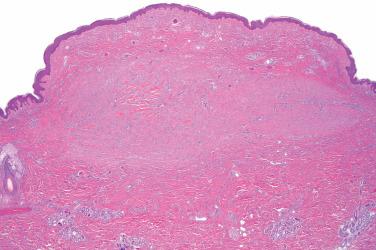
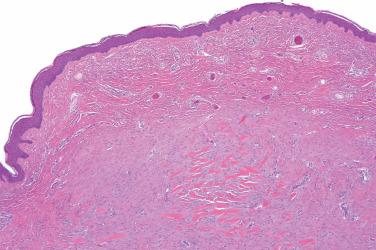
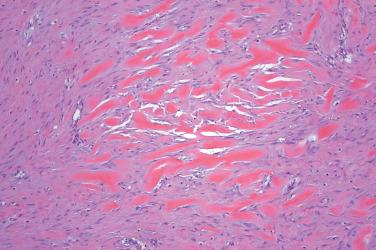
A postnatal disproportionate overgrowth of different tissues associated with cutaneous and extracutaneous manifestations, including also predisposition to different tumors
Results from mosaicism for a mutation that is lethal in nonmosaic state
Mandatory (general) and specific criteria were proposed in 1999 by Biesecker et al. and are reproduced here from their seminal paper
Mandatory (general) criteria
Mosaic distribution of lesion
Progressive course
Sporadic occurrence
Specific criteria (group A, two from group B, or three from group C)
Group A
Connective tissue nevus
Group B
Epidermal nevus
Disproportionate growth (one or more)
Limbs
Skull (hyperostosis)
External auditory meatus (hyperostosis)
Vertebra (megalospondylodysplasia)
Viscera (spleen and/or thymus)
Specific tumors before the end of the second decade (either one)
Bilateral ovarian cystadenomas
Parotid monomorphic adenoma
Group C
Dysregulated adipose tissue (either one)
Lipomas
Regional absence of fat
Vascular malformations (one or more)
Capillary, venous, and/or lymphatic malformation
Facial phenotype
Dolihocephaly
Long face
Minor downslanting of palpebral fissures and/or minor ptosis
Low nasal bridge
Wide or anteverted nares
Open mouth at rest
Skin lesions in Proteus syndrome include
Cerebriform connective tissue nevi (distinctive of the entity)
Epidermal nevi
Vascular malformations
Lipomas
Partial lipohypoplasia
Dermal hypoplasia
Rare disorder with about 200 patients reported in Europe and North America
More common in males
Onset of skin lesions
Congenital or neonatal onset
Usually stable lesions with no or little expansion in the postnatal period
Epidermal nevus and vascular malformations
Delayed onset
Progressive growth in the postnatal period
Cerebriform connective tissue nevus and lipomas
Cerebriform connective tissue nevus
Well-demarcated plaque with rugged cerebriform appearance
Firm consistency
Predilection for soles (can be bilateral) and palms
Other locations much more uncommon, including chest, abdomen, and back
Lesions may be inapparent before the age of 2 years
Epidermal nevus
Flat-topped, brown, hyperkeratotic papules in linear arrangements along Blaschko lines
Soft consistency
Asymmetrical distribution with predilection for trunk and neck
Vascular malformation
Violaceous compressible masses
Predilection for trunk and lower extremities
Lipomas
Soft skin-colored nodules
Predilection for head, abdomen, groin, and legs
Partial lipohypoplasia
Generally presents as areas with reduced fat content, thus displaying accentuated bony contours
Usually restricted to one-half of the trunk or extremities
Dermal hypoplasia
Depressed reddish plaques
Usually associated with decreased subcutaneous fat and absence of hair
Lower extremities
Skin lesions associated with significant morbidity and can be disfiguring
Conservative treatment is preferable for nontumorous proliferations
Connective tissue nevus
Highly collagenized connective tissue
Epidermal nevus
Hyper(ortho)keratosis, acanthosis, and papillomatosis
No adnexal hyperplasia
Vascular malformation
See corresponding chapter
Lipoma
See corresponding chapter
Noncontributory
Klippel–Trénaunay syndrome
Epidermal nevus syndrome
Bannayan–Riley–Ruvalcaba syndrome
Hemihyperplasia multiple lipomatosis syndrome
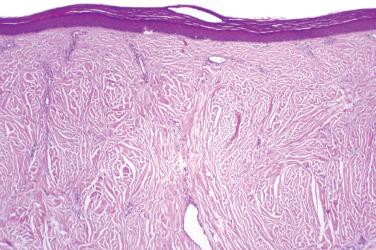
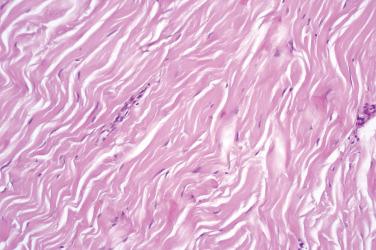
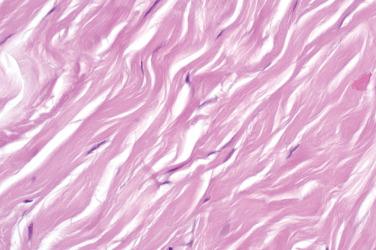
A clonal myofibroblastic proliferation with rearrangement of the USP6 locus located on chromosome 17p13, characterized by a proliferation of bland spindle cells growing in short and loosely arranged fascicles in the background of a myxoid or collagenous stroma
Associated with a nonrandom somatic mutation, yet distinguished by self-limiting growth and spontaneous regression
Young to middle-aged adults from 20 to 40 years of age
No gender predilection
About 10% of lesions develop in children, with male predominance
Solitary, rapidly growing swelling or nodule, developing in the course of a few weeks (up to 8 weeks)
Tenderness over the affected area, lesions can also be asymptomatic
Size usually less than 3 cm (ranges from 0.4 cm to 10 cm)
Predilection for the subcutaneous tissue, fascial planes, or, less often, skeletal muscle of the upper extremities, particularly volar aspects of the forearm, trunk, and head and neck (most common site in children)
Rare sites include intraarticular, visceral, oral cavity, maxillary sinus, and within a nerve
History of previous trauma in up to 20%
Benign self-limiting proliferation
Recurrences after simple excision most unusual
Spontaneous regression common (in a large study, almost 90% of lesions regressed spontaneously after fine needle aspiration biopsy was performed for diagnostic purposes)
Well-delineated and nonencapsulated, margins occasionally more infiltrative
Bland myofibroblastic proliferation
Short, irregular, and intersecting bundles or fascicles
Less often loose storiform or haphazard pattern
Plump vesicular nuclei, a single small nucleolus
Eosinophilic cytoplasm
No or limited nuclear pleomorphism
Mitoses common (from 1 to 10 per 10 high-power fields)
Atypical mitoses absent
Myxoid or fibrous stroma with feathery microcystic appearance (“tissue culture–like”)
Variably abundant
Extravasated red blood cells
Focal frank hemorrhagic areas with hemosiderin deposition (more prominent in intraarticular locations)
Chronic inflammatory cell infiltrate, predominantly composed of lymphocytes, especially at the periphery of the lesion
Metaplastic bone rarely present
Stromal hyalinization (more prominent in intraarticular locations)
Thin, small blood vessels, frequently lined by prominent endothelial cells
Multinucleated giant cells
Early lesions
More cellular proliferation
Loose myxoid matrix
Older lesions
Less cellular, especially toward the center of the lesion with cystic degeneration
Collagenized and hyalinized matrix, occasionally with keloidal appearance
Not contributive, merely confirm fibroblastic/myofibroblastic differentiation
Strongly and diffusely positive for smooth muscle actin and often calponin
Variable positivity for muscle specific actin, and much more infrequently for desmin
Consistently negative for cytokeratins, S100 protein, and CD34
Genomic rearrangement of the USP6 locus on chromosome 17p13 detected in over 90% of cases
t(17;22)(p13;q13) resulting in the fusion gene MYH9-USP6 most common
Desmoid fibromatosis
Leiomyosarcoma
Sarcoma, not otherwise specified (NOS)
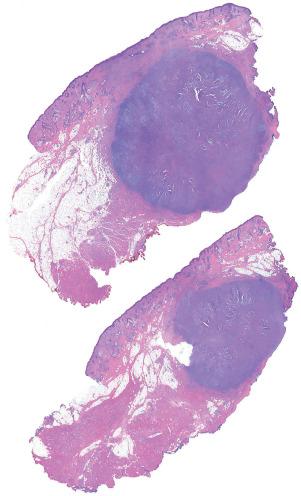
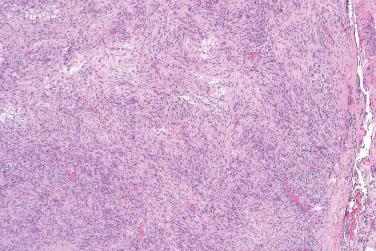
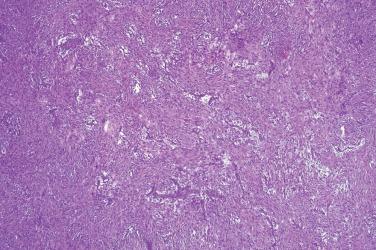
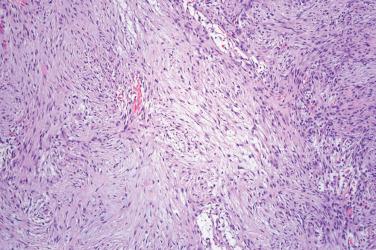
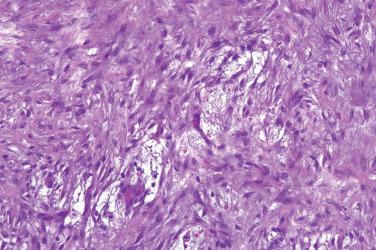
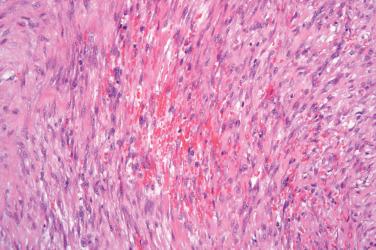
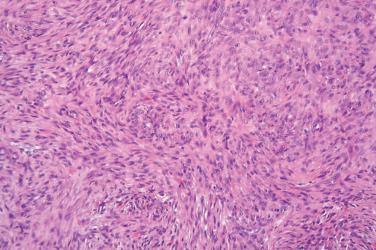
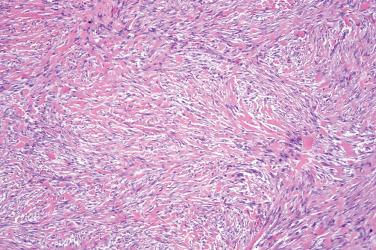
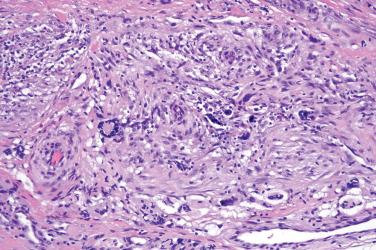
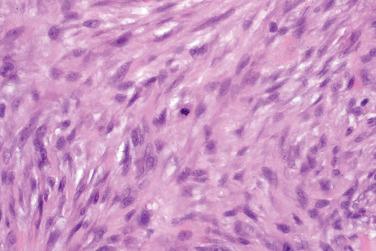
A rare morphological variant of nodular fasciitis occurring exclusively or predominantly within the dermis
No gender predominance
Third decade of life
Solitary painless mass, rapidly growing
Rare superficial ulceration and bleeding
Size ranging from 0.5 cm to 5.5 cm (mean 1.3 cm)
Predilection for limbs and trunk, followed by the head and neck
Benign clinical course
No recurrences after complete excision
Well-circumscribed, nonencapsulated proliferation in the dermis, with possible limited extension into the subcutis
Bland uniform spindle cells
Short intersecting bundles, focal storiform pattern
Elongated tapering nuclei, vesicular chromatin, small nucleoli
No significant cytological atypia or pleomorphism
Mitoses not uncommon (mean number of 2.5 mitoses per 10 high-power fields)
Myxoid to collagenous stroma
Prominent stromal hyalinization with keloid-like areas
Extravasation of red blood cells and hemosiderin deposition
Metaplastic ossification and calcification
Osteoclast-like multinucleated giant cells
Slitlike capillary network
Inflammatory cell infiltrate, usually composed of lymphocytes
Overlying epidermis frequently ulcerated
Smooth muscle actin diffusely and strongly positive
Negative for CD34, desmin, h-Caldesmon, S100 protein, and cytokeratins
HSPle (17p13) rearrangement in most cases
Cellular fibrous histiocytoma
Myofibroma
Superficial angiomyxoma
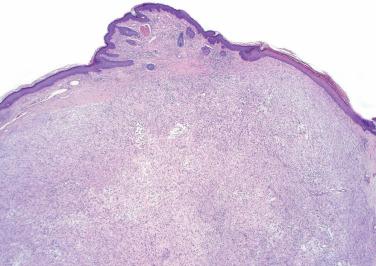
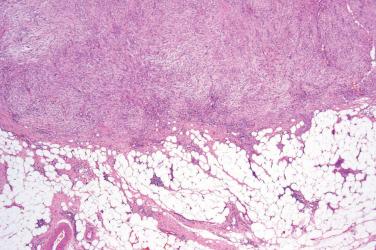
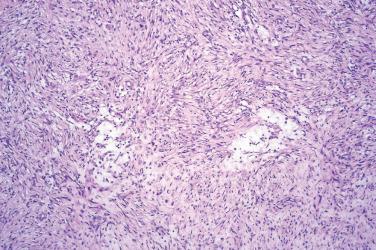
A variant of nodular fasciitis characterized by intralesional metaplastic bone formation
Identical on morphological grounds to myositis ossificans, typically lacking zonation pattern
No gender predilection
Young adults between 20 and 30 years of age
Solitary lesion, well-circumscribed mainly in the superficial soft tissues
Predilection for upper and lower extremities
History of previous local trauma in up to 15% of cases
Benign clinical course
Complete excision curative
Background features of nodular fasciitis (see earlier)
Trabeculae of osteoid and mature woven bone arranged in irregular pattern, lined by bland osteoblasts
Areas of chondroid differentiation and calcifications occasionally present
See nodular fasciitis
HSPle (17p13) rearrangement in most cases
Myositis ossificans
Osteosarcoma
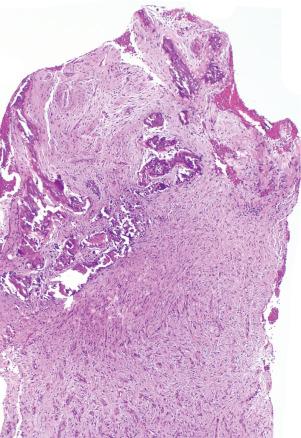
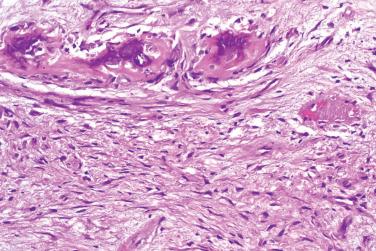
A variant of fasciitis arising in deep soft tissues of the scalp with possible intracranial extension
Male predominance (M : F = 2 : 1), with reversal of the ratio and female predominance with increasing age
Almost exclusively in children, particularly infants
Mean age at presentation about 20 months
Congenital occurrence rare
Rapidly growing firm mass of typically short duration (few weeks)
Involves the deep soft tissues of the scalp, including deep fascia, galea capitis, cranial periosteum, or fibromembranous covers of the sutures with occasional erosion of the underlying bone
Mean size of 2.5 to 3 cm
Extension into or through the skull bone with/without dural involvement possible
Pure intracranial lesions localized to dura mater rare, and as a rule do not involve brain
Association with previous trauma (5%–15%), irradiation or surgical procedure, causative relationship uncertain
A single case associated with familial adenomatous polyposis displaying germline APC mutation with additional acquired somatic nonsense APC mutation reported recently
Benign self-limiting proliferation
Spontaneous regression possible
Simple excision is the treatment of choice
Local recurrence in about 1%
Well-circumscribed proliferation composed of spindle- and stellate-shaped cells in the background of variably myxoid stroma
Myofibroblastic proliferation
Short intersecting bundles or fascicles, focal storiform pattern
Normal mitoses not infrequent, atypical mitoses distinctly uncommon
Minimal nuclear atypia
Cellularity varies, can be prominent
Intervening stroma
Myxoid with typical “tissue culture–like” appearance or collagenous
Thick hyalinized collagen bundles can be prominent
Delicate capillary network
Areas of hemorrhage and/or hemosiderin deposition
Inflammatory cell infiltrate, usually at the periphery
Multinucleated giant cells absent or rare
Focal osseous metaplasia, exceptional
Smooth muscle actin and muscle specific actin positive
Negative for S100 protein, cytokeratins, desmin, CD34
A subsets of lesions display nuclear β-catenin positivity
Relationship to nodular fasciitis is uncertain as HSPle (17p13) rearrangement is not routinely present
Activating mutation to CTNNB1 , the gene encoding β-catenin, has also been noted
Desmoid fibromatosis
Infantile fibrosarcoma
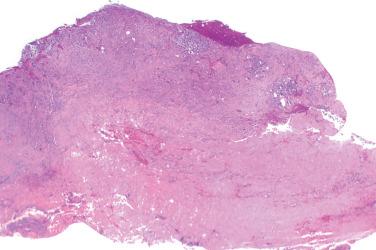
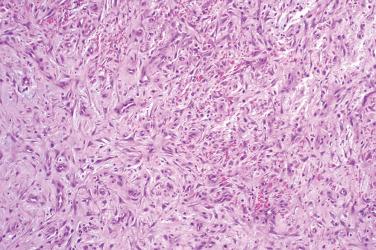
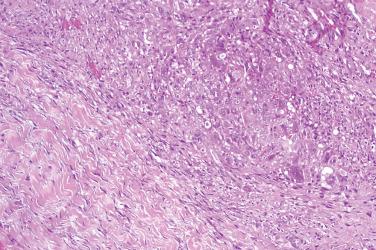
A variant of fasciitis characterized by infiltrative growth along the superficial fascial planes and connective tissue septa of the subcutis and distinguished histologically by an admixture of fibroblasts/myofibroblasts with ganglion-like cells
Likely to represent a superficial counterpart of proliferative myositis
No gender predilection
Predilection for middle-aged adults in the sixth decade of life (mean age about 50 years)
Occurrence in children exceptional
Solitary poorly demarcated mass or nodule in the subcutis
Metachronous appearance in the orbit and forearm recently reported
Rapid growth typical, with the majority of the lesions developing in 2 to 6 weeks
Firm on palpation, movable, and not attached to the overlying skin
Painful in 50% to 75%
Predilection for the upper extremities, particularly volar side of the forearm, followed by the lower extremities, trunk, and head and neck
The majority of lesions less than 3 cm in diameter
Association with previous local trauma in less than 20%, causative relationship uncertain
Benign self-limiting clinical course
Spontaneous regression possible
Conservative complete excision
Recurrences exceptional
Poorly delineated proliferation in the superficial fascia, with frequent multifocal extension into the connective septa of the subcutis and, less frequently, into the underlying skeletal muscle
Exclusive intradermal occurrence recently reported
Two main components are spindle cells (myofibroblasts) and ganglion-like cells embedded in a variably myxoid or collagenous stroma
Spindle cell proliferation
Short intersecting bundles or fascicles, focal storiform pattern
Normal mitoses not infrequent, atypical mitoses distinctly uncommon
Ganglion-like cells
One or two large vesicular nuclei, multinucleated forms much more infrequent
Prominent nucleoli
Abundant basophilic cytoplasm, fibrillary to granular
Loosely arranged or forming small groups
Intervening stroma
Myxoid or collagenous with typical tissue culture appearance
Delicate capillary network
Areas of hemorrhage and/or hemosiderin deposition
Inflammatory cell infiltrate, usually at the periphery
Focal osseous metaplasia, exceptional
Unusual features of lesions developing in children
More circumscribed and less infiltrative growth
Increased cellularity
Predominance of ganglion-like giant cells
Spindle cells
Smooth muscle actin and muscle specific actin positive
Negative for S100 protein, cytokeratins, desmin, CD34
Ganglion-like cells
Variable positivity for CD68
Diploid pattern of DNA flow cytometry
Relationship to nodular fasciitis is uncertain as HSPle (17p13) is not routinely rearranged
Proliferative myositis
Rhabdomyosarcoma
Sarcoma, not otherwise specified (NOS)
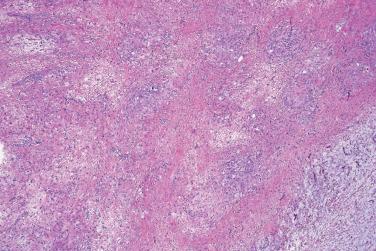
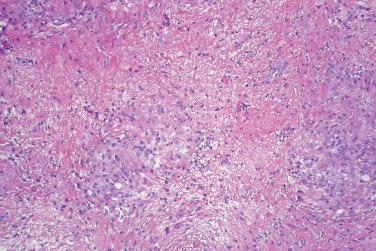
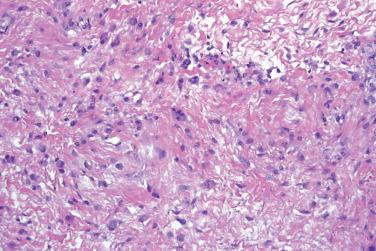
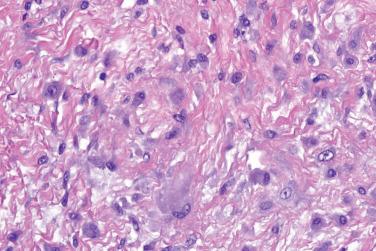
A rare variant of nodular fasciitis occurring within small to medium-sized veins and arteries
Slight male predominance (M : F = 1.4 : 1)
Age distribution wide (from 6 months to 66 years)
The majority occur from the first to the third decade of life
Solitary, slowly growing nodule or mass, occasionally sausage shaped and multilobular
Rapid growth in 2 to 3 weeks reported in rare cases
Nonpainful, associated with discomfort, tender or painful
Multiple lesions within the single area also reported
Size from 0.6 cm to 5 cm
Predilection for head and neck and upper extremity, followed by lower extremity and trunk
Additional sites include oral cavity and periocular soft tissue
Association with previous trauma and/or thrombosis exceptionally reported, causative relationship not clear
An exceptional case developing in a pregnant woman also reported
Benign clinical course
Complete excision curative
Recurrence possible, but unlikely
Typical features of nodular fasciitis (for detailed description see corresponding chapter), featuring plump spindle cells arranged in short intersecting fascicles, focal storiform pattern, or exhibiting a more haphazard growth in the background of variably myxoid stroma
Small to medium-sized arteries and veins, larger vessels can also be affected
Localized within the subcutaneous tissue
Involvement of dermis and deeper soft tissue more infrequent
Intraluminal, intramural, or with possible extramural extension
Infiltrative borders with entrapment of neighboring structures, like perivascular connective tissue, skeletal muscle, and fascia, also rarely reported
Extension from the main vessel into smaller vessels at some distance, creating “satellite” lesions or nodules occasionally present
Multinucleated cells less frequent than in classical nodular fasciitis
Smooth muscle actin positive
Negative for S100 protein, cytokeratins, desmin, CD34, and CD31
Given the rarity of this lesion, HSPle (17p13) rearrangement status, is not well studied
Intravascular pyogenic granuloma
Fibromuscular dysplasia
Sarcoma, not otherwise specified (NOS)
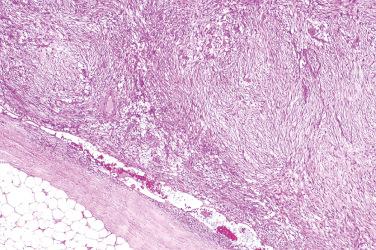
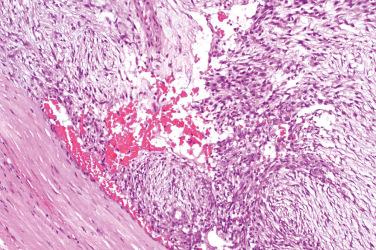
A reactive pseudosarcomatous proliferation of ganglion-like cells and spindle cells with fibroblastic/myofibroblastic differentiation between preserved skeletal muscle fibers forming a typical checkerboard-like growth pattern
Possibly related to local trauma
Adult patients between 40 and 50 years of age
Occurrence in children very rare
Equal gender distribution
Rapidly growing soft tissue mass
Asymptomatic, discomfort, pain
Predilection for the shoulder area, followed by the trunk, proximal extremities, and head and neck
Intraoral occurrence exceptional
Spontaneous regression without particular treatment possible
Recurrences after marginal/incomplete excision distinctly uncommon
Poor circumscription at the periphery
Proliferation of spindle cells and ganglion-like cells within the skeletal muscle, growing in horizontal and vertical planes, resulting in a checkerboard growth pattern
Regular mitoses not uncommon in either component, atypical mitoses absent
Ganglion-like cells
Typically contain large nuclei, one or more prominent nucleoli, and abundant basophilic cytoplasm
Evenly or randomly distributed within the lesion
Degenerative changes of skeletal muscle cells
Myxoid to collagenous stroma, occasionally with areas of osseous or chondroid metaplasia and focal aggregates of mononuclear inflammatory cells
Lesions in children usually more cellular, with predominance of spindle cells, display nodular rather infiltrative growth, better delineation of the lesion, and can contain foci of necrosis
Spindle cells
Smooth muscle actin positive
Variable positivity for CD68
Ganglion-like cells
Variable positivity for CD68 and smooth muscle actin
Negative for neural markers
S100 protein and desmin negative
Cytogenetic analysis of two cases revealed trisomy 2 and translocation t(6;14)
HSPle (17p13) rearrangement not documented in this lesion
Distinction from sarcoma can be difficult in small biopsies
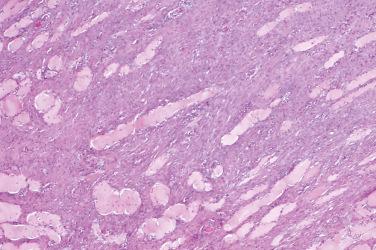
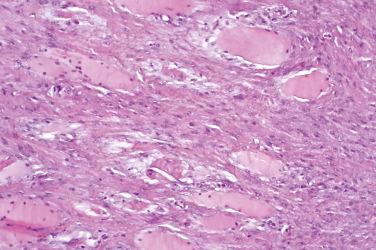
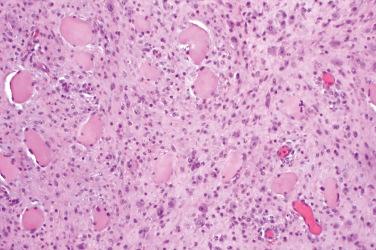
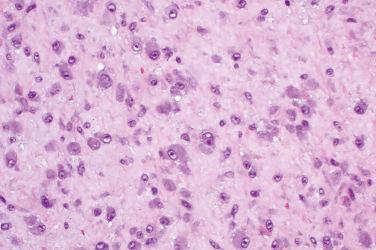
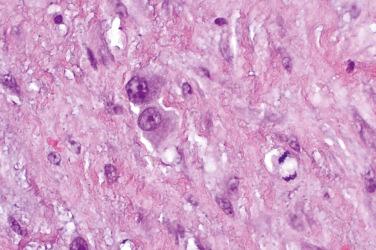
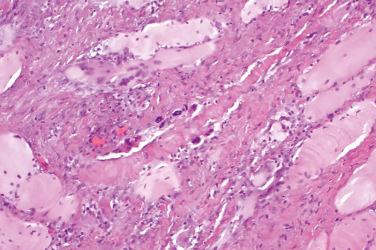
A reactive proliferation typically displaying a zonal appearance with a central area of fibrinoid degeneration/necrosis surrounded by a peripheral area consisting of granulation tissue representing an admixture of fibroblasts, myofibroblasts, blood vessels, and inflammatory cells
Likely related to pressure-induced ischemic injury
Severely debilitated patients under increased risk
Development in otherwise healthy persons increasingly recognized
Also designated as atypical decubital fibroplasia
Elderly patients in the eighth and ninth decades of life predominantly affected
Rare under the age of 50 years
Rare in children
Male predominance
Solitary, painless, ill-defined mass, slowly growing
Surface ulceration generally lacking
Duration usually less than 6 months
Size varies from 1.3 to 10 cm (median size 4.7 cm)
Predilection for soft tissues overlying bony prominences or for sites of increased pressure points, most frequently areas over the sacrum, greater trochanter, shoulder area, buttocks, and posterior chest wall
An unusual location includes the vulvovaginal area
Deep subcutaneous tissue, with possible involvement of the dermis, or deeper structures including skeletal muscles, tendons, and fascia
Exclusive involvement of skeletal muscle exceptional
Simple excision usually curative
Recurrences uncommon, generally related to the persistence of the underlying cause (e.g., pressure-related local ischemia)
Zonal pattern of proliferation
The central area consists of fibrinoid degeneration or necrosis with subsequent formation of pseudocystic spaces
The peripheral area is composed of granulation tissue, representing an admixture of
Spindled and more epithelioid cells with irregular hyperchromatic smudged nuclei, prominent basophilic nucleoli, rare normal mitoses, and variably abundant amphophilic (basophilic) cytoplasm
Large polygonal ganglion-like cells containing round, oval, or reniform hyperchromatic nuclei with prominent nucleoli, similar to the ones present in proliferative fasciitis
Vascular proliferation, frequently containing thrombosed vascular spaces
Mixed inflammatory cell infiltrate
Additional changes include edema, hemorrhage, deposition of hemosiderin, areas of myxoid degeneration, chondroid metaplasia, and fat necrosis/infarction
Generally noncontributory
Variable positivity for smooth muscle actin, desmin, and calponin
Consistently negative for cytokeratins and S100 protein
HSPle (17p13) is not rearranged
Proliferative fasciitis
Proliferative myositis
Nodular fasciitis
Sarcomas of different histogenesis
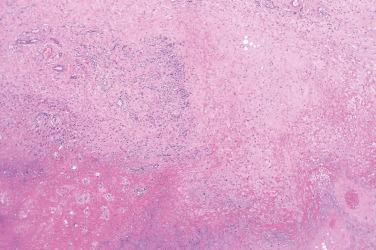
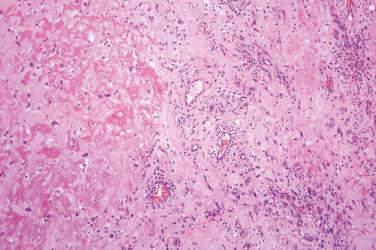
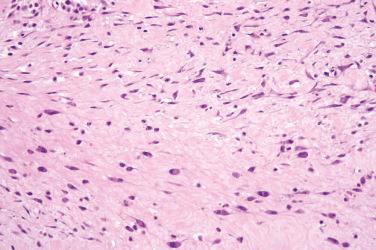
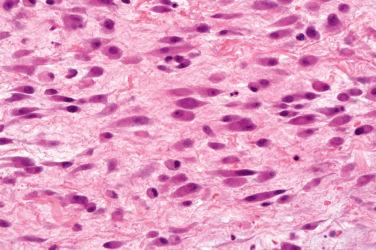
A benign, most likely reactive/degenerative proliferation composed of fibroblasts admixed with abnormal elastic fibers displaying beaded or globular pattern, excessive collagen deposition, and mature fat.
The presence of cytogenetic abnormalities in some cases suggests that the process is neoplastic (see later)
Female predominance (F : M = 4 : 1)
Elderly patients, usually in their sixth to seventh decade of life, or after
Rare in children
Familial occurrence possible, but rare
An autopsy study detected the presence of subclinical elastofibromatous changes in nearly 25% of women and in about 10% of men after the age of 55 years
Poorly demarcated, slowly growing swelling or mass
Asymptomatic, but can also be associated with discomfort, pain, stiffness, limited mobility, and/or snapping of the scapula
Predilection for the infrascapular region (over 95%), in particular, the area between the thoracic wall, the serratus anterior, and the latissimus dorsi muscle
Often attached to the periosteum of the bones of the thoracic wall
Infrequent sites include oral cavity, gastrointestinal tract, orbit, intraspinal space, intraarticular location, neural foramen, ligamentum flavum, ischial tuberosity, greater trochanter, olecranon, chest wall, axilla, inguinal area, deltoid muscle, foot, and greater omentum
Bilateral occurrence in up to two-thirds of cases, either synchronous or metachronous
Multiple lesions at distant locations rare
Size from 5 to 10 cm
Checkerboard white-and-yellow pattern on cut surface due to entrapment of fat
Complete excision curative
Recurrences after incomplete or marginal excision in up to 10%
Hypocellular proliferation of spindled or stellate-shaped fibroblasts
Lack of mitotic activity
Lack of cytological atypia
Broad bands of collagenized stroma
Enlarged, fragmented, and branched elastic fibers resulting in a beaded, globular/discoid or irregularly grained appearance represent the hallmark of the lesion
Interspersed streaks of mature fat in variable proportions
Inflammatory cell infiltrate generally absent
Myxoid degeneration
Formation of pseudocystic spaces
Fibroblasts CD34 and factor XIIIa positive
Elastic fibers can be highlighted by van Gieson stain
Clonal and nonclonal abnormalities mainly affecting chromosome 1 and 3, translocations involving chromosome 8 and 12, and gains of Xq detected in limited number of cases
Not usually relevant due to typical histological features, but nuchal fibroma or desmoplastic fibroblastoma might be considered
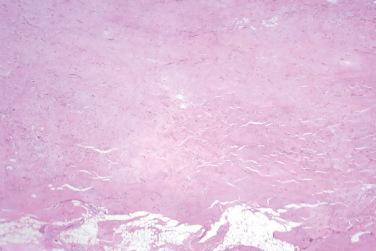
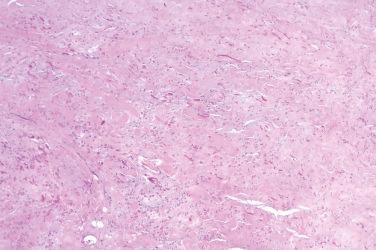
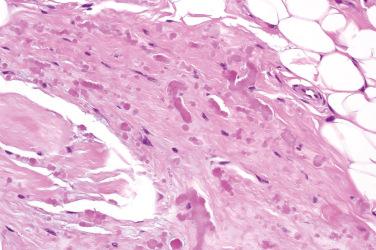
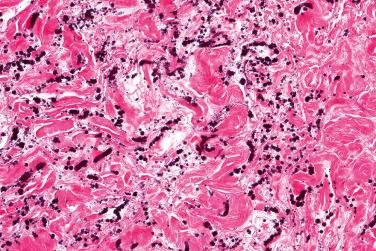
A benign tumor characterized by a plaquelike proliferation of bundles or fascicles of bland myofibroblasts growing in parallel to the epidermis in the superficial parts of the lesion while turning to perpendicular growth in the subcutis, mainly along the connective tissue septa
Papillary dermis typically spared
Female predominance, but pediatric occurrence appears to have nearly equal gender distribution
Most common in the fourth decade of life (mean age 30 years)
Presentation in infancy or early childhood rare
Solitary, slowly growing, indurated plaque or nodule; however, linear and annular variants also described
Multiple lesions exceptionally present
Hypopigmented, skin-colored, or brown-red discoloration
Asymptomatic, occasionally painful
Size from 1.0 to 2.0 cm, giant variants larger than 10 cm also reported
Predilection for shoulder area, upper arm, axillary region, neck, and upper trunk
Pediatric lesion shows predilection for the neck area
Simple excision curative
No recurrences reported even after marginal or incomplete excision
Involvement of the reticular dermis and/or subcutis, whereas the papillary dermis and occasionally also superficial parts of the reticular dermis are usually spared
Ill-defined, plaquelike proliferation with occasional formation of nodules
Cellularity can vary
Bundles and fascicles of bland spindle cells running in parallel to the epidermis, frequently associated with perpendicular growth into the subcutis along the septa
Uniform vesicular nuclei with tapering ends
Absence of cytological atypia
Mitoses absent or rare
Bland eosinophilic cytoplasm
Adnexal structures preserved
Elastic fibers may be increased and fragmented
Additional features
Extravasation of erythrocytes
Proliferation of capillaries
Formation of sievelike and slitlike spaces
Mild inflammatory cell infiltrate
Overlying epidermis normal, but can also be hyperplastic or, rarely, atrophic
Variable positivity for smooth muscle actin, calponin, and muscle specific actin
In some cases smooth muscle actin can be negative
Focal positivity for CD34 not uncommon, but never diffuse
Desmin, h-Caldesmon, S100 protein, β-catenin, EMA, and markers of epithelial differentiation consistently negative
Dermatofibroma
Pilar leiomyoma
Neurofibroma
Dermatofibrosarcoma protuberans
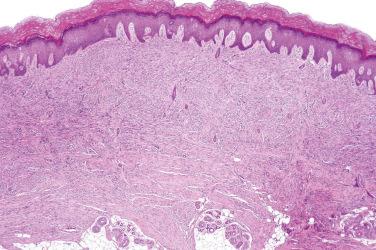
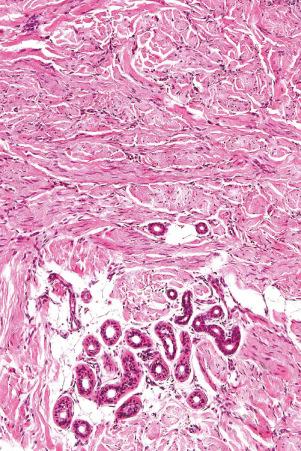
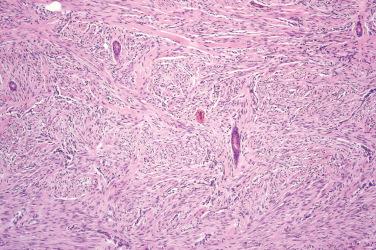
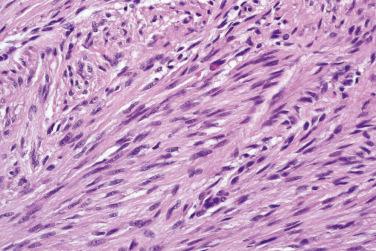
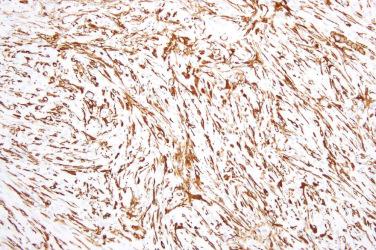
A benign tumor composed of spindled and stellate-shaped fibroblast-like cells growing in a haphazard, storiform, or vague fascicular pattern, set in the background of myxoid, fibromyxoid, or collagenous stroma
Also referred to as digital fibromyxoma
Male predominance (M : F = about 2 : 1)
Adult patients, most commonly around 50 years of age
Solitary
Slowly growing mass
The majority of lesions are smaller than 2 cm in greatest diameter
Asymptomatic (about 50%), tender, or painful
Destruction of nail plate not uncommon
Striking predilection for fingers, particularly subungual or periungual area of the hands and feet
Occurrence outside acral locations an exception
Previous local trauma in a minority of cases, pathogenetic role not clear
Complete excision curative
Recurrences after marginal or incomplete excision in up to 25%
Centered predominantly in the dermis, with possible extension into subcutis
Involvement of deeper structures, including fascia, periosteal surface, and bone, rare
Margins infiltrative and poorly delineated or expansile and well circumscribed
Spindled and stellate cells arranged in haphazard, loose storiform or vague fascicular growth pattern
No or mild nuclear atypia in the majority of cases
Focal areas or scattered cells with moderate to severe nuclear atypia and pleomorphism found in rare cases, thought to be degenerative in nature (enlarged nuclei with irregular contours, hyperchromasia, clumped chromatin, and indistinct nucleoli)
Mitoses rare (fewer than 1 per 10 high-power fields), absence of atypical mitoses
Pale eosinophilic cytoplasm
Multinucleated giant cells (present in about 50%)
Predominantly myxoid, myxocollagenous, or predominantly collagenous stroma/matrix
Vascular proliferation and increased number of mast cells, particularly in myxoid areas
Chondroid and osseous metaplasia rare
CD34 positive
Variable positivity for EMA
Generally negative for cytokeratins, S100 protein, desmin, glial fibrilary acid protein, MUC4, claudin-1
Loss of RB1 (13q14)
Spindle cell lipoma, pleomorphic lipoma, mammary-type myofibroblastoma, and cellular angiofibroma also show RB1 loss
Acquired digital fibrokeratoma
Periungual/subungual fibroma
Cellular myxoma
Superficial angiomyxoma
Low-grade fibromyxoid sarcoma
Dermatofibrosarcoma protuberans
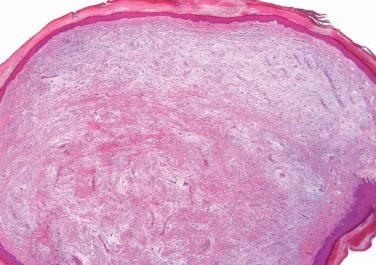
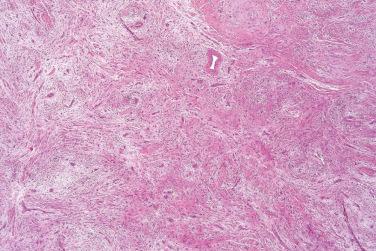
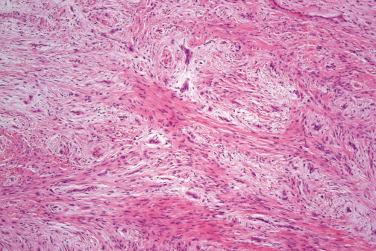
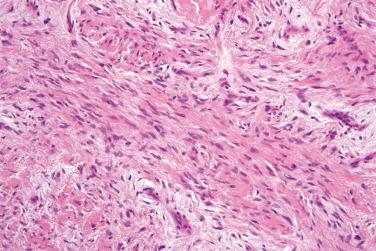
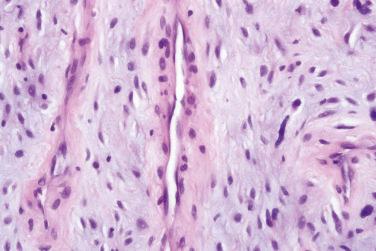
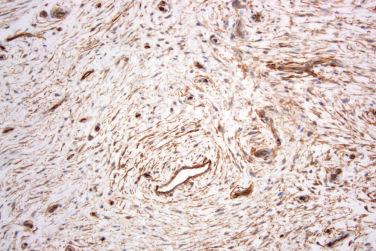
A very common lesion, composed of fibrovascular core, covered by normal or acanthotic epidermis
Also designated acrochordon, skin tag, or soft fibroma (e.g., fibroma mole)
Adult patients
Female predominance
Multiple lesions can be associated with pregnancy, obesity, diabetes, and Birt–Hogg–Dube syndrome
Lesions in children extremely rare, and when present can signify association with nevoid basal cell carcinoma syndrome
Polypoid or pedunculated lesion
Skin colored or hyperpigmented
Size from 0.2 to 5 cm (on average less than 1 cm)
Multiple lesions frequent, developing either synchronously or metachronously
Predilection for skin folds of the neck, axilla and groins, and perianal and genital area; other locations much more infrequent
Benign proliferation
Simple excision generally curative, most commonly performed due to cosmetic reasons
Isolated cases of basal cell carcinoma, squamous cell carcinoma in situ, and invasive squamous cell carcinoma described histologically in the background of a clinically banal fibroepithelial polyp
Lesion generally covered by normal or hyperplastic epidermis
Fibrovascular core containing loose or dense collagen fibers
Lack of skin adnexa within the lesion
Mature fat occasionally abundant
Overlapping features with nevus lipomatosus superficialis
Lesions containing scattered cells with bizarre hyperchromatic nuclei and multinucleated giant cells also referred to as pleomorphic fibromas (see p. 82 )
Not contributory
The bizarre cells in pleomorphic fibroma may be smooth muscle actin positive
Polypoid seborrheic keratosis
Intradermal lipoma
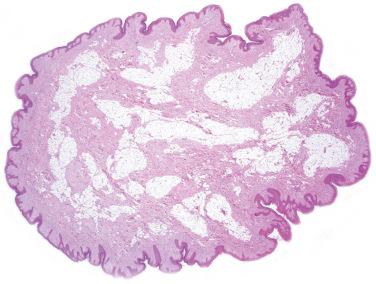
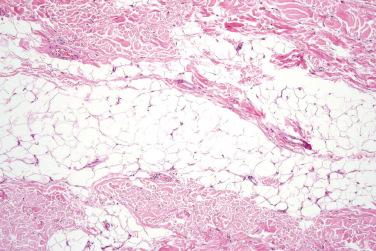
A benign nodular fibroblastic proliferation composed of thick collagen bundles arranged in storiform or whorled pattern, reminiscent of plywood, separated by artifactual clefts and containing scattered spindled or stellate-shaped fibroblasts
Multiple cutaneous lesions, in addition to or without oral mucosal lesions, represent a hallmark of Cowden syndrome
An autosomal-dominant disorder caused by germline mutations in the PTEN gene
Associated with increased risk of visceral malignancies, particularly breast (often bilateral), thyroid, and endometrial carcinoma
Solitary lesions can also be associated with Cowden syndrome, albeit much more infrequently
Alternatively designated storiform collagenoma
Giant cell collagenoma represents a distinctive subtype and is generally not associated with Cowden syndrome
No gender predominance
All age groups can be affected, including children
Slow-growing, skin-colored or erythematous papule or nodule
Firm on palpation, asymptomatic
Solitary lesion or multiple occurrence
Size up to 1 cm
No site predilection
Complete excision curative
Recurrences distinctly uncommon
Papillary dermis frequently unaffected
Well-circumscribed, nonencapsulated hypocellular proliferation in the dermis
Thick collagen bundles arranged in a storiform or whorled pattern
Collagen bundles separated by prominent artifactual clefts
Cleftlike spaces may contain copious amounts of mucin
Scattered spindled or stellate-shaped fibroblasts among collagen bundles, with no or with mild nuclear pleomorphism and absence of mitotic activity
Multinucleated giant cells occasionally present, dispersed among collagen bundles
Defining feature of giant cell collagenoma (regarded as a subtype of sclerotic fibroma)
Foreign body type, Touton type, Langhans type, and/or floretlike
Bizarre-shaped, crowded vesicular nuclei, frequently overlapping
Small prominent nucleoli
Mitoses generally absent
Pale cytoplasm
Absence of elastic fibers and adnexal structures within the lesion
Epidermis overlying the lesion usually atrophic
CD34 and CD99 positive
Consistently negative for smooth muscle actin, desmin, calponin, S100 protein, and EMA
Sclerotic fibroma-like pattern in inflammatory lesions, for example, folliculitis, chronic fibrosing vasculopathy (erythema elevatum diutinum)
Sclerotic fibroma-like pattern in various neoplastic lesions, including dermatofibroma, neurofibroma, melanocytic nevus, lipoma, fibroma of tendon sheath, angiofibroma
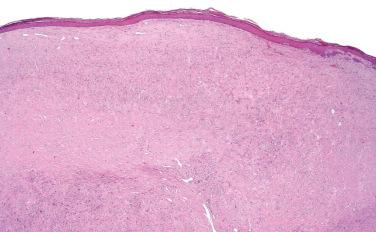
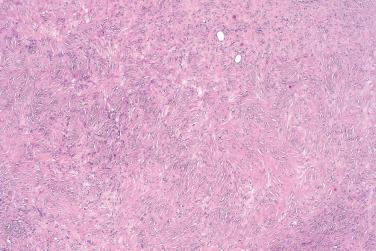
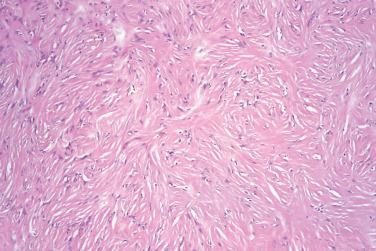
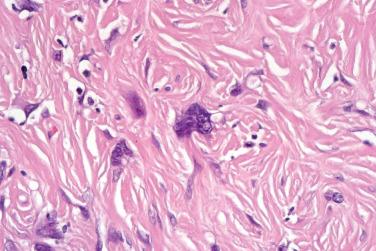
A benign hypocellular proliferation composed of spindle-shaped, stellate, epithelioid, and multinucleated fibroblasts/myofibroblasts with variable degenerative atypia amid the background of haphazardly arranged collagen bundles
Middle-aged and older adults (sixth decade of life)
Male predominance
Solitary
Polypoid or dome-shaped papule
Predilection for extremities and trunk, followed by the head and neck area
Complete excision curative
Recurrences after incomplete excision very rare
Well-circumscribed, nonencapsulated, hypocellular dermal proliferation
Spindle-shaped, stellate, epithelioid, and multinucleated (often floretlike) giant cells with degenerative atypia
Large pleomorphic hyperchromatic nuclei and small nucleoli
Mitotic activity absent or infrequent, yet atypical mitoses occasionally seen
Thick and haphazardly arranged collagen bundles with slitlike spaces
Additional features
Mature adipose tissue, likely the results of metaplastic change
Stroma with areas of hyalinization, sclerosis, and/or myxoid degeneration
Inflammatory cell infiltrate, composed of lymphocytes and histiocytes
Dilated blood vessels with or without areas of hemorrhage
Inconsistent positivity for smooth muscle actin, muscle specific actin, factor XIIIa, and CD34
Sclerotic fibroma (likely represents part of a spectrum)
Giant cell collagenoma
Atypical fibrous histiocytoma
Giant cell fibroblastoma
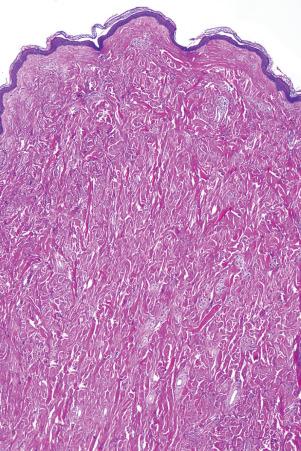
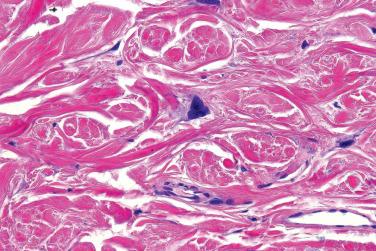
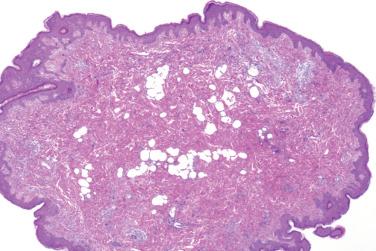
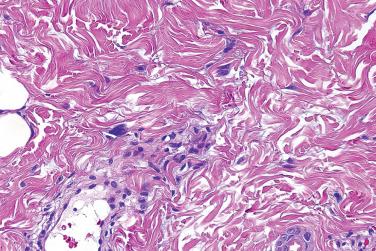
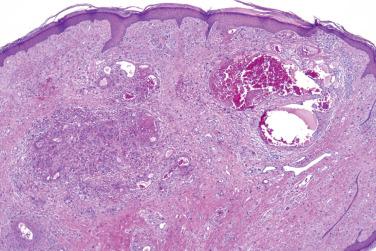
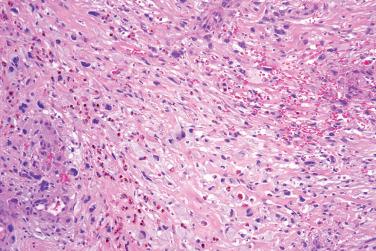
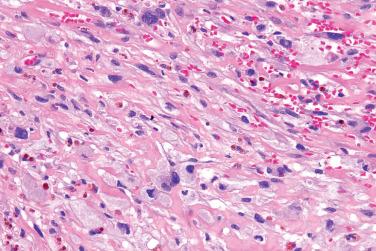
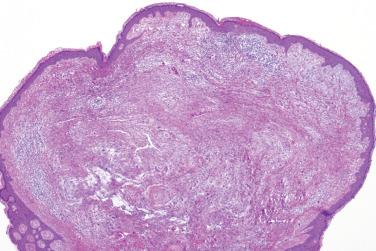
A paucicellular, reactive proliferation composed of thick and haphazardly arranged collagen fibers, without significant increase in the number of fibroblasts, typically containing entrapped lobules of mature fat, peripheral nerve endings, and traumatic neuroma-like nerve proliferation
Designated also as collagenosis nuchae
Lesions at extranuchal sites alternatively designated as nuchal-type fibromas
Fibroblastic proliferation(s) in Gardner syndrome, also called Gardner-associated fibroma(s) or Gardner fibroma, essentially indistinguishable from nuchal fibroma on histological grounds
Male predominance
Nuchal fibromas generally occur in adult patients (mean age about 40 years)
Extranuchal fibromas tend to develop at younger age (mean age 25 years)
Occurrence in children should raise the suspicion of Gardner fibroma in the background of Gardner syndrome
Solitary, poorly circumscribed, ill-defined mass
Multiple lesions exceptionally present, either within the same topographical area or at distant sites
Asymptomatic, mild discomfort or pain
Nuchal fibromas tend to be smaller (mean diameter about 4 cm) than extranuchal fibromas (mean diameter 6 cm)
Predilection for posterior neck, interscapular, and paraspinal areas
Extranuchal locations in about one-third, including back, shoulder, face, buttock, and extremities
Associated conditions include diabetes mellitus (up to 50%), previous local trauma, and much more infrequently scleroderma and scleredema
Collision with dermatofibrosarcoma protuberans reported in an exceptional case, likely coincidental
Generally not associated with familial adenomatous polyposis or desmoids tumors (in contrast to Gardner fibroma)
Complete excision curative
Nondestructive recurrences in over 40% at extranuchal sites
Predominantly centered in the subcutaneous fatty tissue
Extension into the dermis not uncommon, whereas involvement of skeletal muscle(s) or deeper structures rare
Paucicellular proliferation
Thick collagen bundles arranged in haphazard pattern, but vague lobular arrangement can be appreciated toward the center of the lesion
Cracking artifacts between collagen bundles
Scattered fibroblasts between collagen bundles
Entrapment of lobules of mature fat and nerve endings typical for the entity, but skin adnexa can also be entrapped
Traumatic neuroma-like proliferation of small nerves frequently present
Perineural fibrosis occasionally present
Number of elastic fibers within the lesion typically reduced
Mild inflammatory cell infiltrate, composed of lymphocytes, occasionally present
CD34 (up to 80%) and CD99 positive
Negative for smooth muscle actin, β-catenin, desmin, S100 protein
Gardner fibroma
Connective tissue nevus
Desmoid-type fibromatosis
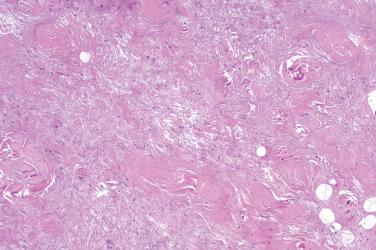
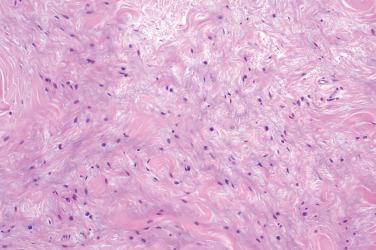
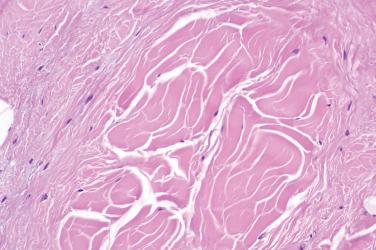
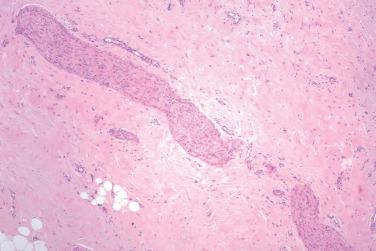
A paucicellular fibroblastic proliferation, composed of haphazardly arranged thick collagen bundles separated by cracks, containing sparse spindled fibroblasts and entrapped fat lobules and nerve fibers, especially at the periphery
Indistinguishable histologically from nuchal fibroma
Of paramount importance due to its association with familial adenomatous polyposis (FAP)
Detected in almost 70% of FAP patients in a recent study, but this can be an underestimate due to the lack of familial history, a new APC mutation, sporadic occurrence, or
Can represent an initial manifestation of Gardner syndrome
About 10% of patients with Gardner fibroma have familial history of desmoid fibromatosis
Gardner syndrome
A subtype of familial adenomatous polyposis, an autosomal dominantly inherited condition due to mutation(s) in the APC gene
Multiple colonic adenomas with 100% risk of malignant transformation if left untreated
Extracolonic manifestations include, among others, fibromas, desmoid fibromatosis, epidermal inclusion cysts, osteomas, fibrous dysplasia of the skull, supernumerary teeth, and thyroid carcinoma
Children and young adults
About 30% diagnosed in the first year, almost 80% in the first decade, 15% in the second decade, and less than 10% after the third decade
Slightly more common in males (M : F = 1.2 : 1)
Slowly growing, ill-defined plaque of rubbery consistency
Solitary lesions more common than multifocal tumors (concurrent or subsequent)
Size from 0.3 to 12 cm (mean size 3.9 cm)
Most frequently on the back and paraspinal region (78%), followed by the head and neck area (14%), extremities (14%), and chest/abdomen (11%)
Benign behavior
Concurrent or subsequent development of desmoid fibromatosis with or without prior precipitating factor (trauma and/or surgery) in about 20% of cases
Poorly circumscribed proliferation in the superficial (subcutis/dermis) and/or deep soft tissue (deeper to the fascia with skeletal muscle involvement)
Hypocellular proliferation
Haphazardly arranged thick collagen bundles often associated with cracking artifact
Spindled or fusiform fibroblasts scattered between collagen bundles
Small capillary-sized blood vessels between collagen bundles, frequently compressed
Entrapment of fat lobules and peripheral nerve fibers, especially at the periphery
Lack of nodularity and fascicular growth
Increased number of small nerve twigs/bundles (traumatic neuroma-like), as in nuchal fibroma, usually not present
Can be associated with desmoid fibromatosis, characterized by fascicular growth and more prominent cellularity (see corresponding chapter)
Positive for CD34, cyclin D1, and c-Myc
Variable β-catenin nuclear positivity (in about 70% of cases)
Negative for smooth muscle actin, desmin
Nuchal fibroma
Desmoid fibromatosis
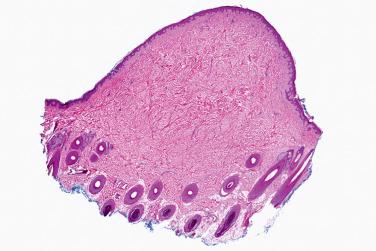
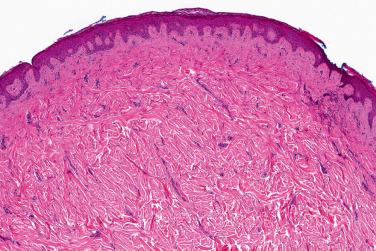
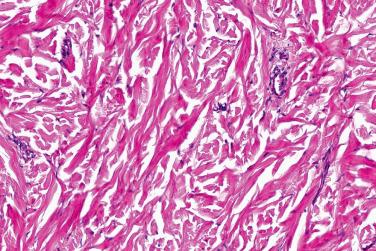
A reactive/reparative lesion within the nuchal ligament composed of nodular proliferation of fibroblasts and mature cartilage, representing a metaplastic fibrocartilaginous process
Usually associated with previous local trauma or chronic mechanical stress
Degenerative process (e.g., arthritis or arthropathy) can alternatively contribute to the development of the lesion in a minority of cases
An identical lesion recently reported on the plantar foot
Equal gender distribution
Adult patients in the third to fifth decade of life
Lesions in children extremely rare, generally trauma related
Slowly growing mass or nodule
Poorly delineated
Asymptomatic, associated with stiffness or painful
Size generally less than 3 cm in greatest diameter
Localized within the nuchal ligament; surrounding structures can also be affected
Predilection for the deep soft tissue of the lower cervical spine at the junction of nuchal ligament and deep cervical fascia at the level of C4–5 and C5–6
Complete excision curative
No recurrences reported after complete excision
Poorly delineated and moderately cellular proliferation of fibroblasts and chondroblasts forming a nodule
Both cellular components fairly uniform, lacking cytological atypia(s), nucleoli, and mitotic activity
Chondroblasts frequently arranged in short cords or strands, binucleated cells within lacunae generally absent
Fibroblastic component often paucicellular
Disorganization of collagen and fragmentation of elastic fibers within the lesion
Inflammation, hemorrhage, or deposition of hemosiderin generally absent
Degenerative changes of the nuchal ligament surrounding the central area of fibrochondrous metaplasia with fragmentation of elastic fibers
CD34 positivity in both fibroblastic and chondroblastic component
Chondroid areas display S100 protein positivity
Negative for desmin and CD99
Soft tissue chondroma
Nuchal fibroma
Myositis ossificans
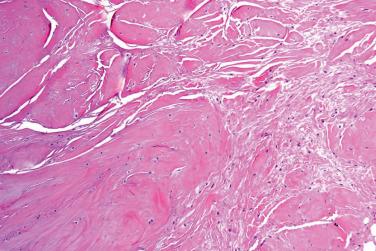
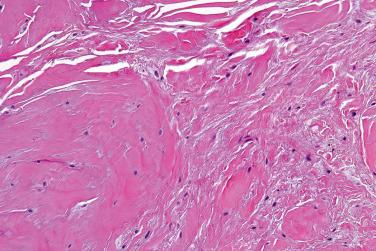
A reactive paucicellular proliferation of fibroblasts embedded in collagenous stroma within the sternocleidomastoid muscle resulting in shortage and lack of contractility of the muscle
Also designated as sternocleidomastoid tumor of infancy or congenital torticollis
Possibly related to trauma of the affected region at birth, ischemia, or intrauterine malposition; the exact pathogenesis is still unknown
Incidence of 0.4% live births
Slight male predominance (M : F = 1.5 : 1)
Over 90% of the lesions present before the age of 3 months, usually between first and eighth week of life
Delayed presentation in adults has been reported
Familial occurrence in less than 5% with possible autosomal-dominant pattern of inheritance
Nontender, firm, fusiform swelling within the sternocleidomastoid muscle
Initial rapid growth for several weeks, followed by stabilization of the lesion with lack of additional growth lasting for several months, with subsequent spontaneous diminution or complete regression of the lesion within the first year of life
Nodular proliferation can be associated with ipsilateral tilting of the head and contralateral head rotation (e.g., torticollis) in about 20% to 25%
The lesion typically measures between 1 and 3 cm in diameter
The majority of the lesions are solitary, bilateral occurrence being exceptional
Overlying skin generally normal; hyperpigmentation and hypertrichosis reported in a single case
Spontaneous resolution in 50% to 80%, usually within the first year
Initial treatment should be conservative, including physical therapy, heat, and massage
Surgical therapy (usually in less than 10%) restricted for lesions nonresponsive to conservative treatment
Late complications include delayed torticollis and craniofacial asymmetry
Proliferation of bland spindled fibroblasts associated with variable amount of collagenous matrix between skeletal muscles with replacement of skeletal muscles resulting in the formation of predominantly hypocellular collagenous mass
Skeletal muscles frequently atrophic with accompanying degenerative changes
Inflammatory cell infiltrate generally absent
Become a Clinical Tree membership for Full access and enjoy Unlimited articles
If you are a member. Log in here